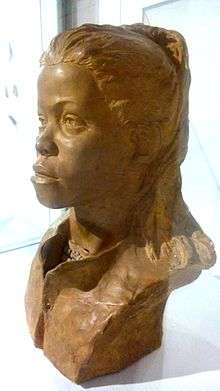Sungir
Coordinates: 56°10′33″N 40°30′33″E / 56.17583°N 40.50917°E

Sungir (sometimes erroneously spelled Sunghir) is an Upper Paleolithic archaeological site in Russia and one of the earliest records of modern Homo sapiens in Europe. It is situated about two hundred kilometres east of Moscow, on the outskirts of Vladimir, near the Klyazma River. It is dated by calibrated carbon analysis to between 32,050 and 28,550 BC. Additional pollen finds suggest the relative warme spell of the "Greenland interstadial (GI) 5" [1] between the 305th and 301st centennia BCE as most probable dates.
The settlement area was found to have four burials: the remains of an older man and two adolescent children are particularly well-preserved, and the nature of the rich and extensive burial goods suggests they belonged to the same class. In addition, a skull and two fragments of human femur were also found at the settlement area, and two human skeletons outside the settlement area without cultural remains.[2]
History


The site was discovered in 1955, in the course of local digging from clay pits. Some 4500 square miles were excavated in sixteen field seasons between 1957 and 1977 (Bader 1965; 1967; 1978; 1998). Archeology teams from the Geological Institute of the Russian Academy of Science (R.A.S.), University of Groningen, Oxford University, and the University of Arizona in the United States have all worked on the excavations and related studies to review the findings from the site.
They determined that the cultural layer was located in what is called Bryansk soil, related to the period (thirty-two to twenty-four millennia ago) of the corresponding interstadial of the Valdai Ice age of the Late Pleistocene. Evidence of only surface dwellings on the site led the team to conclude it was likely used seasonally.
Burials
Graves 1 and 2 at Sungir are described as "the most spectacular" among European Gravettian burials.[3] The adult male was buried in what is called Grave 1 and the two adolescent children in Grave 2, placed head-to-head, together with an adult femur filled with red ochre.[3] The three people buried at Sungir were all adorned with elaborate grave goods that included ivory-beaded jewelry, clothing, and spears. More than 13,000 beads were found (which would have taken 10,000 hours to produce). Red ochre, an important ritual material associated with burials at this time, covered the burials.[3]
The children are considered a twin burial, thought to have ritual purpose, likely sacrifice. The findings of such complete skeletons are rare in late Stone Age, and indicate the high status of the male adult and children. The children had the same mtDNA,[2] which may indicate the same maternal lineage, but more would need to be known about other people in the settlement.
The site is one of the earliest examples of ritual burials and constitutes important evidence of the antiquity of human religious practices. The extraordinary collection of grave goods, the position of the bodies, and other factors all indicate it was a burial of high importance.[2] Two other remains at the site are partial skeletons.
The remains are held by the Institute of Ethnology and Anthropology of R.A.S., Moscow. In 2004, the International Seminar, "Upper Paleolithic People from Sunghir, Russia," was hosted by the Department of Archaeology, University of Durham, U.K. It is the second of two major conferences about this site.[2]
Two books have been published in Moscow about the findings. Upper Palaeolithic Site Sungir (graves and environment) (1998) was the first complete publication about the site, including an inventory of artifacts, reconstruction of the Paleolithic man's clothes, archaic counting and calendar. The second part of the book displays the reconstruction of the environment by geological, palinological, zoological data.[2]
The second book, Homo Sungirensis (2000) edited by T.I. Alexeeva et al.(see below), includes articles published since the first book, and new anthropological data derived from morphology, palaeopathology, X-ray study, histology, trace elements and molecular genetic analyses. It has an illustrated catalogue of all the skeletal materials.[2]
References
- ↑ http://www.iceandclimate.nbi.ku.dk/research/strat_dating/annual_layer_count/gicc05_time_scale/
- 1 2 3 4 5 6 The Sunghir archaeological site, hosted by Institute for Bioarcheology, Moscow State University, accessed 24 September 2013
- 1 2 3 M. Dobrovolskaya, M.-P. Richard, E. Trinkaus, "Direct Radiocarbon Dates for the Mid Upper Paleolithic (Eastern Gravettian) Sunghir Burials from Russia", Bull. Mem. Soc. Anthropol. Paris, 2011, accessed 24 September 2013
Further reading
- Upper Palaeolithic Site Sungir (graves and environment) (Posdnepaleolitischeskoje posselenije Sungir), ed. by N.O. Bader, Y.A. Lavrushin. Moscow: Scientific World. 1998.
- Homo Sungirensis. Upper Palaeolithic man: ecological and evolutionary aspects of the investigation, ed. by T.I. Alexeeva, N.O. Bader, A.P. Buzhilova, M.V. Kozlovskaya, M.B. Mednikova. Moscow: Scientific World, 2000.
- The People of Sunghir. Burials, Bodies, and Behavior in the Earlier Upper Paleolithic., Erik Trinkaus, Alexandra P. Buzhilova, Maria B. Mednikova, Maria V. Dobrovolskaya. Oxford University Press, New York 2014
External links
- Von Schulz, Matthias. "Todeskampf der Flachköpfe" (German), Der Spiegel online, 20 March 2000